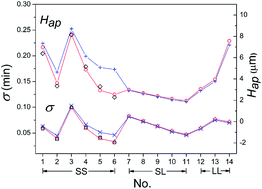Evaluation of the peak variance in gradient liquid chromatography†
Abstract
The peak variance obtained under single stepwise (SS), single linear (SL) and ladder-like (LL) gradient conditions was evaluated by taking into account the variation of plate height with mobile phase composition. LC tests were performed on a C18 column using a mixture of methanol and water as the mobile phase and six aromatic compounds (anisole, o-cresol, biphenyl, phenol, aniline and acetophenone) as the model samples. It was found that the relationship between the retention factor and mobile phase composition could be described by the linear solvent strength model. The plate height that was measured under isocratic conditions varied with mobile phase composition. This variation could be described by a quadratic polynomial in this work. Under gradient conditions, the experimental and predicted values of peak variance were found to be well consistent. The discrepancy between the experimental and predicted values in the SS gradient was larger than that in the SL or LL gradient. This may be ascribed to the distortion of the gradient profile as a result of dispersion that occurred in the mobile phase. By using the dispersive gradient profile that was obtained at the column inlet for the calculation, the discrepancy between the experimental and predicted values in the SS gradient may be minimized.


 Please wait while we load your content...
Please wait while we load your content...